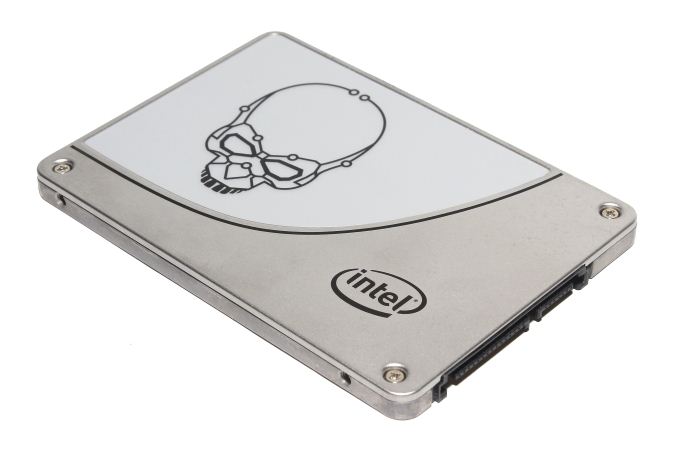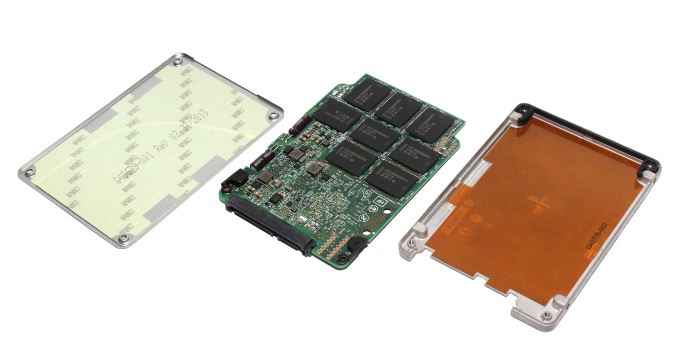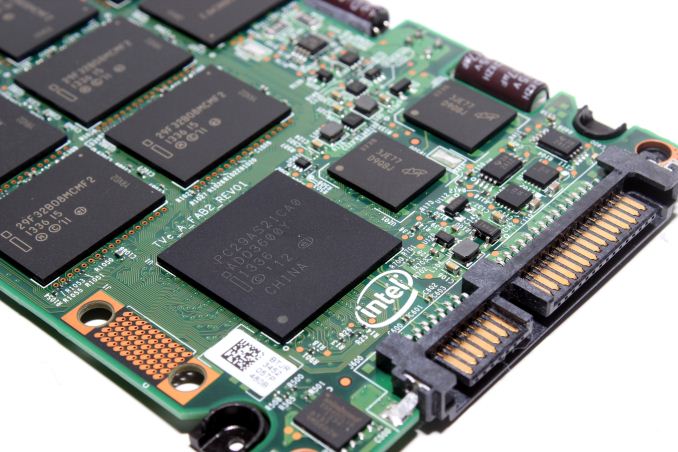Intel SSD 730 (480GB) Review: Bringing Enterprise to the Consumers
by Kristian Vättö on February 27, 2014 12:00 PM EST- Posted in
- Storage
- SSDs
- Intel
- Intel SSD 730

The days of Intel being the dominant player in the client SSD business are long gone. A few years ago Intel shifted its focus from the client SSDs to the more profitable and hence alluring enterprise market. As a result of the move to SandForce silicon, Intel's client SSD lineup became more generic and lost the Intel vibe of the X-25M series. While Intel still did its own thorough validation to ensure the same quality as with its fully in-house designed drives, the second generation SandForce platform didn't allow much OEM customization, which is why the SSD 520 and other SandForce based Intel SSDs turned out to be very similar to the dozens of other SandForce driven SSDs in the market.
The SSD market has matured since the X-25M days and a part of the maturing process involves giving up profits. Back in 2007-2008 the SSD market (both client and enterprise) was a niche with low volume and high profits, so it made sense for Intel to invest in custom client-oriented silicon. There wasn't much competition and given Intel's resources and know-how, they were able to build a drive that was significantly better than the other offerings.
The high profits, however, attracted many other manufacturers as well and in the next few years Intel faced a situation it didn't like: profit margins were going down, yet bigger and bigger investments had to be made in order to stay competitive in the client market. OCZ in particular was heavily undercutting Intel's pricing and big companies with technological and scale advantage like Intel tend not to like the bargain game because at the end of the day it's not as profitable for them. The enterprise market is a bit different in this regard because price is not usually the commanding factor; instead the focus is on reliability, features and performance, which made it an easy choice for Intel to concentrate its resources on covering that market instead.
For the majority of consumers this change in focus was negligible since the likes of Micron and Samsung had started paying attention to the retail consumer SSD market and Intel was no longer the only good option available. However, enthusiasts were left yearning for an Intel SATA 6Gbps design as many had built brand loyalty for Intel with the X-25M. In late 2012 the wishes materialized but to their disappointment only in the form of an enterprise SSD: the DC S3700. This verified that enterprise was Intel's first priority but given that it was a SATA 6Gbps rather than a PCIe design, it left hope for a more client-orientated in-house Intel solution. Fast-forward to today and that solution is now here. Please meet the SSD 730, Intel's new client flagship.
Adopting the platform from the DC S3500/S3700, the SSD 730 is Intel's first fully in-house designed client drive since the SSD 320. The SSD 730 is not just a rebranded enterprise drive, though, as both the controller and NAND interface are running at higher frequencies for increased peak performance. While the branding suggests that this is an enterprise drive like the SSD 710, Intel is marketing the SSD 730 directly to consumers and the DC S3xxx along with the 900 series remain as Intel's enterprise lineups. And in a nod to enthusiasts, the SSD 730 adopts the Skulltrail logo to further emphasize that we are dealing with some serious hardware here.
| Capacity | 240GB | 480GB |
| Controller | Intel 3rd Generation (SATA 6Gbps) | |
| NAND | Intel 20nm MLC | |
| Sequential Read | 550MB/s | 550MB/s |
| Sequential Write | 270MB/s | 470MB/s |
| 4K Random Read | 86K IOPS | 89K IOPS |
| 4K Random Write | 56K IOPS | 74K IO |
| Power (idle/load) | 1.5W / 3.8W | 1.5W / 5.5W |
| Endurance | 50GB/day (91TB total) | 70GB/day (128TB total) |
| Warranty | Five years | |
| Availability | Pre-orders February 27th - Shipping March 18th | |
Intel is serious about the SSD 730 being an enterprise-class drive for the client market as even the NAND is pulled from the same batch as Intel's MLC-HET NAND used in the S3700 and the endurance rating is based on JEDEC's enterprise workload. JEDEC's SSD spec, however, requires that client SSDs must have a data retention time of one year minimum whereas enterprise drives must be rated at only three months, which gives the S3500/S3700 a higher endurance. MLC-HET also trades performance for endurance by using lower programming voltages, resulting in less stress on the silicon oxide.
| Intel SSD 730 | Intel SSD 530 | Intel SSD DC S3500 | Intel SSD DC S3700 | |
| Capacities (GB) | 240, 480 | 80, 120, 180, 240, 360, 480 | 80, 120, 160, 240, 300, 400, 480, 600, 800 | 100, 200, 400, 800 |
| NAND | 20nm MLC | 20nm MLC | 20nm MLC | 25nm MLC-HET |
| Max Sequential Performance (Reads/Writes) | 550 / 470 MBps | 540 / 490 MBps | 500 / 450 MBps | 500 / 460 MBps |
| Max Random Performance (Reads/Writes) | 89K / 75K IOPS | 48K / 80K IOPS | 75K / 11.5K IOPS | 76K / 36K IOPS |
| Endurance (TBW) |
91TB (240GB) 128TB (480GB) |
36.5TB |
140TB (200GB) 275TB (480GB) |
3.65PB (200GB) 7.3PB (400GB) |
| Encryption | - | AES-256 | AES-256 | AES-256 |
| Power-loss Protection | Yes | No | Yes | Yes |
Continuing with the enterprise features, there is full power-loss protection similar to what's in the S3500/S3700. I'm surprised that we've seen so few client SSDs with power-loss protection. Given the recent studies of power-loss bricking SSDs, power-loss protection should make a good feature at least in the high-end SSDs.
Test System
| CPU |
Intel Core i5-2500K running at 3.3GHz (Turbo and EIST enabled) |
| Motherboard | AsRock Z68 Pro3 |
| Chipset | Intel Z68 |
| Chipset Drivers | Intel 9.1.1.1015 + Intel RST 10.2 |
| Memory | G.Skill RipjawsX DDR3-1600 4 x 8GB (9-9-9-24) |
| Video Card |
Palit GeForce GTX 770 JetStream 2GB GDDR5 (1150MHz core clock; 3505MHz GDDR5 effective) |
| Video Drivers | NVIDIA GeForce 332.21 WHQL |
| Desktop Resolution | 1920 x 1080 |
| OS | Windows 7 x64 |
Thanks to G.Skill for the RipjawsX 32GB DDR3 DRAM kit












96 Comments
View All Comments
Mr Perfect - Friday, February 28, 2014 - link
Because it's edgy and cool, and what the youf are looking for in a SSD... Or at least according to the guys in marketing it is.arvivaz - Monday, March 3, 2014 - link
Not satanic. Just a skull. But its really witty. The skull is tilted like its looking at a PC screen and that looks like a smile. Skin's blown away from the power of the hardware, I suppose. Note the electrical/electronic symbols hidden in the skull. Pretty good.star-affinity - Monday, March 17, 2014 - link
What's so satanic about it? I think it resembles quite well the skull we all carry around…amddude10 - Friday, November 28, 2014 - link
I bought one of these because of its wear tracking/ drive monitoring features, significantly better than crucial m500 power loss protection, high endurance, and long warranty. I didn't buy this SSD for gaming, yet I find the skull endearing. This drive certainly seems likely to live up to the "hardcore" image of the skull, at least in terms of reliability/durability.danjw - Thursday, February 27, 2014 - link
No support for built in encryption, kills that product in my eyes. Sure, the consistency is nice, but I don't see ever using drives that don't have encryption capabilities. That, said I am much more security conscious than most consumers. I always secure wipe drives once I retire them. I care enough to make sure my drives have the on drive encryption enabled. These are for the people that think over much of the Intel brand and think Windows Firewall and Security Essentials are actually a good security choice.PEJUman - Thursday, February 27, 2014 - link
I say having common sense is the best security choice, more so than any specific program/brand of firewall-antivirus.I see the market for this SSD as near workstation class desktops @ semi-pro/pro setting (think small business). you would be secured behind your IT (camera, chassis intrusion alarm, etc). Not to mention your data on the SSD will be server-backed, negating most of the benefit of encryptions.
I honestly think Intel is no longer chasing true consumer/enthusiast (or anyone with price/performance considerations).
DesktopMan - Thursday, February 27, 2014 - link
Since this SSD isn't optimized for mobile, encryption doesn't make all that much sense due to limited ATA password support on mainstream motherboards. Also makes sense that they want to differentiate from the enterprise drive.beginner99 - Thursday, February 27, 2014 - link
Exactly. Encryption is more relevant in laptops and this clearly isn't a laptop drive. That being said I do not see a market for this drive. It's a tiny, tiny niche. The 840 Evo is faster and way cheaper, the M500 is like half the price albeit slower it has more features and I doubt one notices much difference in normal usage scenarios.zyxtomatic - Thursday, February 27, 2014 - link
You can also use the whole disk encryption option in your OS (Windows Bitlocker, Mac FileVault, etc) if your drive doesn't have hardware encryption. The performance hit really isn't that bad, and it protects your data just as well as hardware encryption does. I've been using it on my work and personal laptops for years and it's never been a problem.chrnochime - Saturday, March 1, 2014 - link
And the Evo is in a long line of SSDs that have consistently have drive failures for users within the span of several months, as seen on user reviews. Who gives a shit about faster when it's like playing lottery with using the drive anyway.